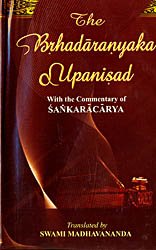Brihadaranyaka Upanishad
The Bṛhadāraṇyaka Upaniṣad (with the Commentary of Śaṅkarācārya)
by Swāmī Mādhavānanda | 1950 | 272,359 words | ISBN-10: 8175051027
This Upanishad is widely known for its philosophical statements and is ascribed to Yajnavalkya. It looks at reality as being indescribable and its nature to be infinite and consciousness-bliss. Ethics revolve around the five Yajnas or sacrifices. This book includes the english translation of the Bhāṣya of Śaṅkara. The Shankara-Bhashya is the most ...
Section IV - Meditation on Satya Brahman
Verse 5.4.1:
तद्वै तदेतदेव तदास—सत्यमेव; स यो हैतं महद्यक्शं प्रथमजं वेद सत्यं ब्रह्मेति, जयतीमाँल्लोकान्; जित इन्न्वसावसत्, य एवमेतं महद्यक्शं प्रथमजं वेद सत्यं ब्रह्मेति; सत्यं ह्येव ब्रह्म ॥ 1 ॥
इति चतुर्थं ब्राह्मणम् ॥tadvai tadetadeva tadāsa—satyameva; sa yo haitaṃ mahadyakśaṃ prathamajaṃ veda satyaṃ brahmeti, jayatīmām̐llokān; jita innvasāvasat, ya evametaṃ mahadyakśaṃ prathamajaṃ veda satyaṃ brahmeti; satyaṃ hyeva brahma ॥ 1 ॥
iti caturthaṃ brāhmaṇam ॥1. That[1] (intellect-Brahman) was but this—Satya (gross and subtle) alone. He who knows this great, adorable, first-born (being) as the Satya-Brahman, conquers these worlds, and his (enemy) is thus conquered and becomes nonexistent—he who knows this great, adorable, first-born (being) thus, as the Satya-Brahman, for Satya is indeed Brahman.
In order to enjoin a meditation on that Brahman called Hṛdaya (intellect) as Satya, the present section is being introduced. That refers to the intellect-Brahman. The particle ‘vai’ is a reminder. That intellect-Brahman who may be recalled—is the meaning of. the first ‘Tat’ (that). He is being described in another way—is the meaning of the second ‘Tat.’ What is that way? He was but this. With this last word the third ‘Tat.’ is connected. ‘This’ refers to something in the mind that will presently be stated. Who ‘was but this’? He who has been described as the intellect-Brahman; here the third ‘Tat’ comes in. What is he? This is being specified as Satya alone—the Satya-Brahman, or Brahman that is ‘Sat’ and ‘Tyat,’ the gross and subtle elements, in other words, consisting of the five elements. He, any one, who knows this being identified with Satya—great, because of his vastness, adorable, first-born, since this Brahman was born before all other relative beings—as the Satya-Brahman, gets the following result: As the Satya-Brahman has made all these worlds a part of himself, or conquered them, so he who knows the great, adorable, first-born Brahman identified with Satya, conquers these worlds. Also his enemy—this word is understood—is thus conquered, as the worlds are by Brahman, and becomes non-existent, i.e. is conquered. Who gets this result? To answer this the text concludes: He who knows this great, adorable, first-born (being) thus—as the Satya-Brahman. Hence the result is aptly in accordance with the meditation, for Satya is indeed Brahman.
Footnotes and references:
[1]:
The pronoun ‘Tat’ (that or it) occurs thrice in the text. The last two (as well as the particle ‘Vai’) have been omitted in the translation to avoid confusion. They are explained in the commentary.
